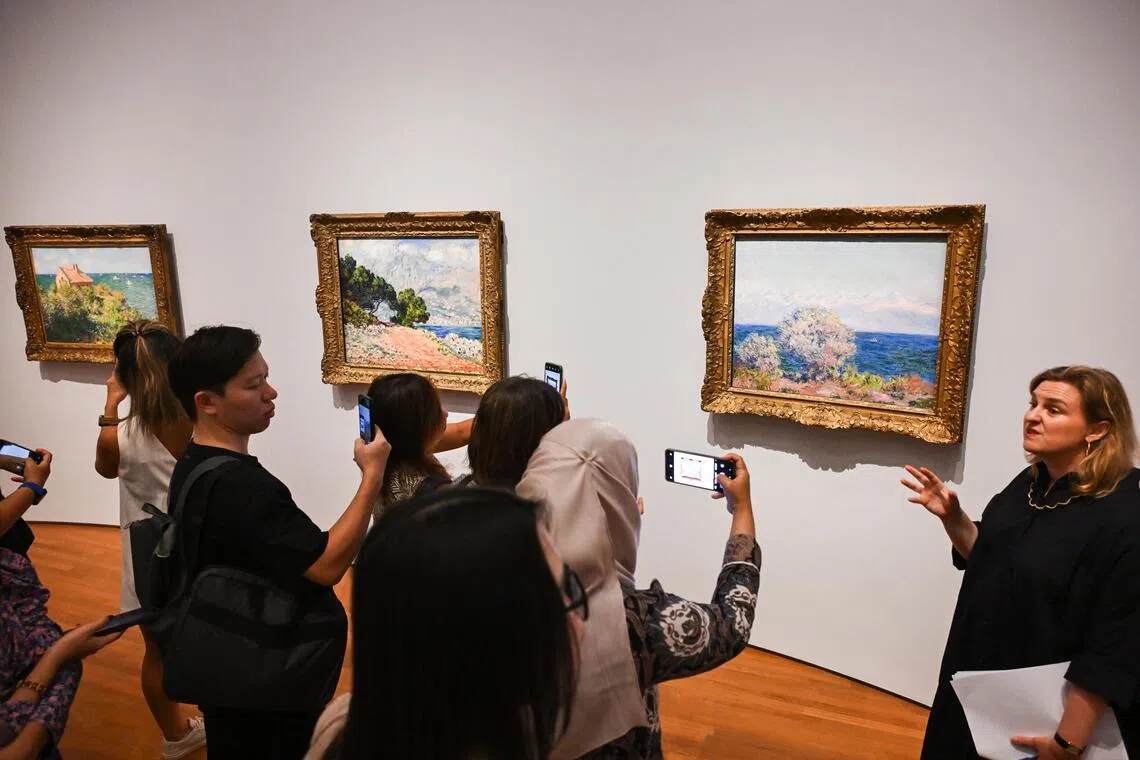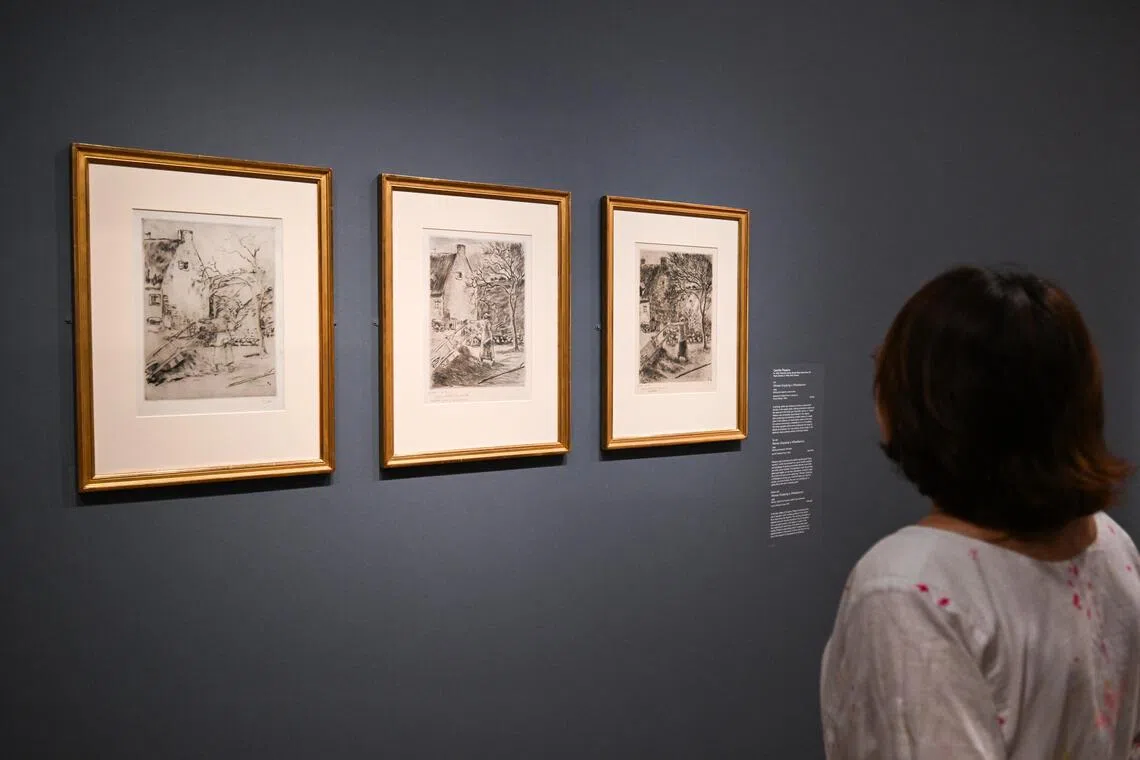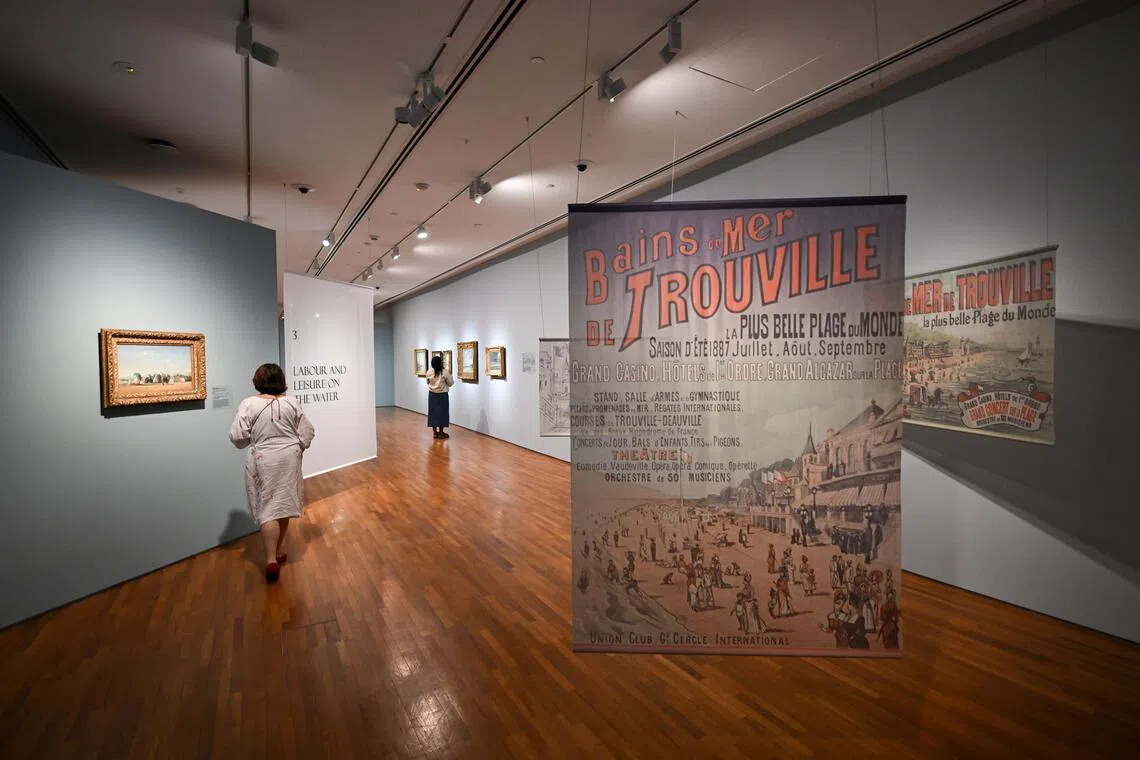Radical and modern: Impressionist masterpieces at National Gallery Singapore
Sign up now: Get ST's newsletters delivered to your inbox
Follow topic:
SINGAPORE – Midway through National Gallery Singapore’s new blockbuster exhibition Into The Modern: Impressionism From The Museum Of Fine Arts, Boston, the parade of familiar names is interrupted by an unexpected display.
Singapore art educator and painter Lim Yew Kuan’s prints are given prominent space alongside a display of printmaking tools. A quartet of etchings dedicated to Paris’ Place Vendome sits next to a trio of woodblock prints, including a Self Portrait, all made in the early 1960s.
These prints, illustrating experiments in the medium, are a surprising choice to juxtapose against the more famed Impressionist classics.
Dr Phoebe Scott, senior curator at the gallery, says this is a deliberate decision by the curatorial team, which includes curatorial assistants Alexis Chen and Celine Ho.
“Many people will be surprised by that selection, and that was part of our intention because we also wanted people to rethink what Impressionism actually means,” says Dr Scott.

Dr Phoebe Scott (right) leading a curator’s tour of Into The Modern: Impressionism From The Museum Of Fine Arts, Boston at National Gallery Singapore.
ST PHOTO: SHINTARO TAY
“Experimental print work is an important part of Impressionism, even though it’s now so much more associated with painting. In fact, Degas, Cassatt and Pissarro were obsessed with print at a certain point in time and they changed the way print was used as a modern medium.”
The show, featuring more than 100 works by 25 artists, opens at National Gallery Singapore on Nov 14.
The choice of Lim, a second-generation painter, is also surprising in the Singapore context since it is the Nanyang pioneers who are most often associated with the French art movements of the early 20th century.
Artists Georgette Chen and Liu Kang famously studied in Paris and were influenced by the post-Impressionists such as Paul Cezanne and Paul Gauguin.
Dr Scott adds: “We also wanted to offer a very different vantage point about the meaning of the legacies of Impressionism in Singapore and South-east Asia. The Nanyang painters borrowed aspects of Impressionism, but alongside Cubism, alongside Post-Impressionism, alongside batik and all sorts of South-east Asian references, and what they created was markedly different from the Impressionism of the original movement.”
The gallery’s show, which has been in the making for some three years, reframes the Impressionists for a modern audience by emphasising how ground-breaking the artists were in terms of both technique and their focus on everyday life.
Lim’s quartet of etchings, for example, resonates with a display of Camille Pissarro’s Woman Emptying A Wheelbarrow. This series of four etchings, progressively deepening and darkening as the artist added more details for each print, showed how Pissarro experimented with the technique, achieving almost painterly effects by the final textured version.

Woman Emptying A Wheelbarrow by Camille Pissarro at National Gallery Singapore’s Impressionism show, Into The Modern.
ST PHOTO: SHINTARO TAY
His focus on a simple countrywoman was a statement too about the dignity of human labour.
A century after the early Impressionist artists rocked the sedate art institutions of their time, the world has come to regard their visual language as pretty poetics, forgetting that their choice of content was as politically progressive as their works were technically innovative.
Pissarro, for example, was known for his bucolic rural scenes, but he was also a lifelong anarchist with strong beliefs about egalitarianism.
Dr Scott says: “The Impressionists worked in a time of very drastic social change in the second half of the 19th century. Political chaos and turmoil had led to government change and divisive politics. Industry was radically changing the landscape and the nature of work.”
Paris, where many of these artists lived and worked, was undergoing rapid urbanisation, with forested areas being cleared for lumber and development, the Seine getting dredged to facilitate trade and industry, and dilapidated neighbourhoods being razed by Georges-Eugene Haussmann, the prefect of Seine, who built the wide boulevards, luxuriant parks and elegant buildings which now define the city.
This urban redevelopment, Dr Scott notes, was a drastic transformation, “creating new social spaces, new forms of mass entertainment”.
Hence, the exhibition design juxtaposes the painters’ works with large-scale reproductions of archival materials – from old photographs to vintage posters – hung up in the form of banners which allow visitors “to connect to that idea of modernity and perhaps even recognise some features of it, things that we still experience in the world today”.

Oversized reproductions of vintage posters and other archival material set works in context at National Gallery Singapore’s exhibition.
ST PHOTO: SHINTARO TAY
Dr Scott says: “We featured photography in the Fontainebleau section because it was so striking that almost exactly the same images that the Impressionist painters wanted to capture were also being captured by photographers.
“In some ways, the picturesque aesthetic crosses between photography and painting. So, our idea that photography is more objective while painting is more expressive is kind of wrong. They actually share many pictorial preoccupations.”
Impressionist painters even borrowed photographic strategies for composition.
She points to Edgar Degas’ innovative compositions, which used cropping or cut effects, or strange vantage points. These strategies come “from the experience of the photographic image where the scene is cut wherever the photograph ends, rather than composed to the end of it”.
The show’s presentation in Singapore differs drastically from how the same pieces were shown at the National Gallery of Victoria in Melbourne, Australia, during its run from June to October.
Dr Scott says that while the exhibition in Melbourne sought more to capture the ambience of the 19th century, the Singapore curators wanted to find a way to make these masterpieces relevant to a contemporary Asian audience.
“We really wanted to make an argument about why there’s still something meaningful to find in these works and to really dig deep to discover what that is.”
Since the gallery first held the Colours Of Impressionism exhibition with Impressionist works from Paris’ Musee d’Orsay in 2017, these painters have also become favourite subjects of immersive digital experiences.
But Dr Scott says there is nothing like the real thing. “If people come and see them, they will feel something. There’s an emotional resonance to the real work that can get through across the generations.”
Book It/Into The Modern: Impressionism From The Museum Of Fine Arts, Boston
Where: National Gallery Singapore, 1 Andrew Road str.sg/AeXsp
When: Nov 14 to March 1, 10am to 7pm daily
Admission: $15 for Singaporeans and residents, $25 for tourists
Info:


